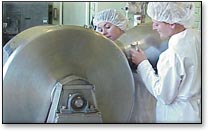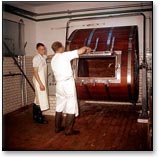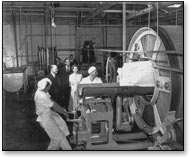1. Traditional batch churning from 25- 35% mf. cream.
2. Continuous flotation churning from 30-50% mf. cream. A typical continuous churning machine, a Contimab, is shown at right.
3. The concentration process whereby "plastic" cream at 82% mf. is separated from 35% mf. cream at 55 C and then this oil-in-water elulsion cream is inverted to a water-in-oil emulsion butter with no further draining of buttermilk.
4. The anhydrous milkfat process whereby water, SNF (solids-not-fat, i.e., proteins, lactose, minerals, acids, enzymes, vitamins), and salt are emulsified into butter oil in a process very similar to margarine manufacture.
An optimum churning temperature must be determined for each type of process but is mainly dependent on the mean melting point and melting range of the lipids, as discussed above , i.e., 7-10 °C in summer and 10 - 13 °C in winter. If churning temperature is too warm or if thermal cycle permits to much liquid fat than a soft greasy texture results; if too cold or too much solid fat than butter too brittle and sticky.
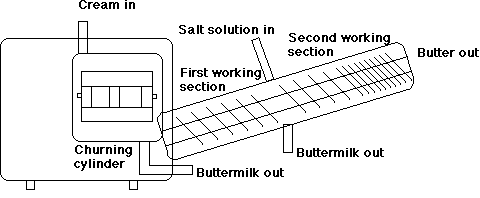
Continuous Flotation Churns
There are two methods of continuous butter making: one involving the accelerated churning of normal cream and the other the utilization of reseparated high-fat cream.
The cream is first fed into a churning cylinder fitted with beaters that are driven by a variable speed motor.
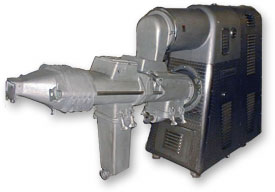 Rapid conversion takes place in the cylinder and, when finished, the butter grains and buttermilk pass on to a draining section. The first washing of the butter grains sometimes takes place en route - either with water or recirculated chilled buttermilk. The working of the butter commences in the draining section by means of a screw which also conveys it to the next stage.
Rapid conversion takes place in the cylinder and, when finished, the butter grains and buttermilk pass on to a draining section. The first washing of the butter grains sometimes takes place en route - either with water or recirculated chilled buttermilk. The working of the butter commences in the draining section by means of a screw which also conveys it to the next stage.
On leaving the working section the butter passes through a conical channel to remove any remaining buttermilk. Immediately afterwards, the butter may be given its second washing, this time by two rows of adjustable high-pressure nozzles. The water pressure is so high that the ribbon of butter is broken down into grains and consequently any residual milk solids are effectively removed. Following this stage, salt may be added through a high-pressure injector.
The third section in the working cylinder is connected to a vacuum pump. Here it is possible to reduce the air content of the butter to the same level as conventionally churned butter.
In the final or mixing section the butter passes a series of perforated disks and star wheels. There is also an injector for final adjustment of the water content. Once regulated, the water content of the butter deviates less than +/- 0.1%, provided the characteristics of the cream remain the same.
The finished butter is discharged in a continuous ribbon from the end nozzle of the machine and then into the packaging unit.
Concentration Method
- 30% fat cream pasteurized at 90 °C
- degassed in a vacuum
- cooled to 45 - 70 °C
- separated to 82% fat ("plastic" cream)
- the concentrate, still an O/W emulsion, is cooled to 8 - 13 °C
- fat crystals forming in the tightly packed globules perforate the membranes, cause liquid fat leakage and rapid phase inversion
- contrast to mayonnaise, also a o/w emulsion at 82% fat but is winterized to prevent crystallization
- butter from this method contains all membrane material, therefore, more phospholipids
- no butter milk produced
- after phase inversion the butter is worked and salted.
Phase Separation
Butter from anhydrous milkfat :
- prepare "plastic" cream (>80% fat)
- heat with agitation to destabilize emulsion
- separate oil from aqeous phase: 82 to 98% butter fat
- this butter oil is then blended with water, salt and milk solids in an emulsion pump and transferred to scraped surface heat exchanger for cooling and to initiate crystalization
- further worked to develop crystal structure and texture
- process similar to margarine manufacture
- margarine has advantage of fat composition control to modify physical properties
- butter produced by phase separation contains few phospholipids.

